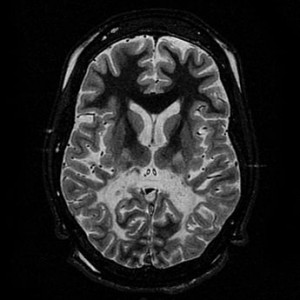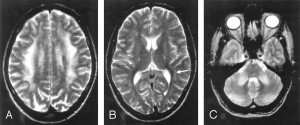MUTATION STORY: LEUKODYSTROPHIES
PART 1: The Story
My name is Alexander, and I was born yesterday.
Technically, I go by many names – Metochromatic leukodystrophy, Krabbe, Canavan – but that doesn’t matter too much. I’m hungry, and I have a craving for the fatty, white matter of Abe’s brain and the nerve fiber inside.
I only got here because the cells messed up, and their wall, the myelin sheath, isn’t as protected as it should be. I’m not too sure why – neither are the doctors, to be fair – but it’s either because something went missing in Exon 16, in the GALC gene and sparked a premature STOP codon, the ARSA genes never showed up to the party, or some other mutation in the GFAP or ASPA genes. Either way, some amino acids got mixed up and all the cells got confused. There was a small, nearly undetectable system failure, and I was born. Created to eat away at this little boy’s brain, until he goes into a vegetative state and his brain stops firing neurons everywhere.
But there’s so much to do before that! I have to disrupt the electrical molecules in his brain, just enough so that they slow down a bit, and Abe’s muscles stop functioning properly. His parents won’t understand, and neither will the doctors, until they conduct a  MRI. They’ll think it’s MS, until they see less white on the brain then there should be. They won’t see me though, and even if they do, Abe will be crying too much for them to care. He’s only a babe, yet so sensitive to sounds and lights. He’s not fascinated by them, like the other babies are – he’s scared, and they’re irritating them more than anything. But he’ll grow up a bit, and his parents won’t know that it was the father’s fault, but he couldn’t have known until the worst happens. Abe will be diagnosed with epilepsy, and as if that doesn’t worry Mr. and Mrs. Cooper enough, he’ll inhale his saliva and wake them to his desperate, rattled coughing.
MRI. They’ll think it’s MS, until they see less white on the brain then there should be. They won’t see me though, and even if they do, Abe will be crying too much for them to care. He’s only a babe, yet so sensitive to sounds and lights. He’s not fascinated by them, like the other babies are – he’s scared, and they’re irritating them more than anything. But he’ll grow up a bit, and his parents won’t know that it was the father’s fault, but he couldn’t have known until the worst happens. Abe will be diagnosed with epilepsy, and as if that doesn’t worry Mr. and Mrs. Cooper enough, he’ll inhale his saliva and wake them to his desperate, rattled coughing.
Sometimes, I start to feel bad. Abe was a good newborn, didn’t cry too much and made the Cooper’s so irrevocably happy. Sure, his head was tilted a little bit backwards, but they didn’t care. He was theirs, and he was perfect. Until he wasn’t, of course. But a mutation’s got to eat.
Abe will live till about seven years old. He’ll attend kindergarten, but also the doctor’s office regularly. They’ll pump him full of medications to prevent the pain and control his muscles, but they won’t be able to get rid of me. I’ll keep eating until there’s nothing left, until the nerve fibres fall apart and there’s no longer any neurons telling his arms to move, his lungs to breathe.
The Cooper’s will cry once his heart stops beating. They’ll wish it took him faster, but only because his last words were “Mommy, it hurts”. They’ll ask “Why Abe?” every night before they go to bed, but it’s not up to me if it’s in the same house or not. He was so excited for school, and to learn how to write his name, even if his hands didn’t work like all the other’s kids. He couldn’t see too much, and the teacher had to wear a device around her neck, synced to the aid in his ear, just so he could hear her speak. She’ll be sad too, but the kids won’t understand. They won’t even be able to pronounce “leukodystrophy”.
The parents will also follow the debates about the “treatment” for me. Lawyers will argue about the ethics of it, whether they should be prolonging the life or attempting to save it. “Treatment”. As if I’m some bacteria, some virus. I’m just a genetic mutation.
But I can’t be sure, exactly. I was only born yesterday.
PART 2: The Making of the Mutation Story
- What questions did you need to research in order to create your mutation story?
- What does leukodystrophy mean? What does it really do?
- What are the physical symptoms?
- How is it caused? Is it inherited or spontaneous?
- What are the treatments?
- How can it arise in adulthood, while it is inherited by the parents and progresses quickly?
- Is it fatal?
- What new or familiar digital tools did you use while working on this project?
- I used foundation and clinic sites for research rather than mostly Wikipedia.
- I also used Wikipedia though, and only used information that was cited. Wikipedia is a handy resource.
- What was the process you used to investigate this topic?
- I Googled “leukodystrophy” and chose some sites that looked promising.
- As I read through them, I searched any terms I did not know and any other questions I had.
- How did you verify and cite the information you found?
- Most of the information I got was from the sites that would normally be used as a source, as they were the sites of foundations and clinics that specialised in this particular mutation. Wikipedia cited these sources as well.
- As for me citing them myself, the sources are at the bottom of this page.
- How did the process of completing this challenge go? What could you have done better?
- The assignment itself wasn’t necessarily difficult. I’m pretty good at writing stories and processing information, so that didn’t take very long, but I found I was worrying about the assignment because not much had been done up until Thursday. I probably shouldn’t have left it for so long, but the assignment did come during the busiest week of the semester.
SOURCES:
www.ninds.nig.gov/disorders/leukodystrophy/leukodystropjy.htm
www.ulf.org/what-is-leukodystrophy
https://en.wikipedia.org/wiki/Leukodystrophy
http://www.healthline.com/health/metachromatic-leukodystrophy#Long-TermOutlook6

